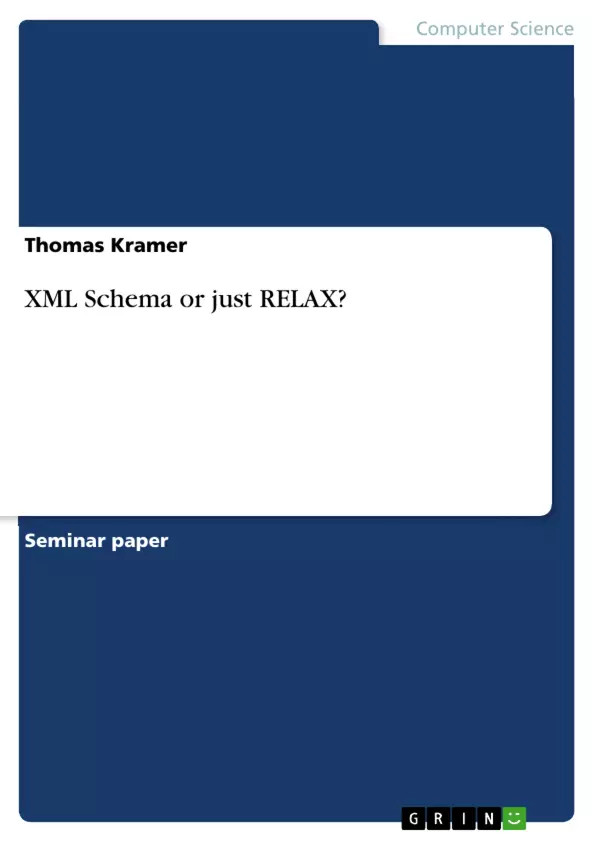Today′s e-business consists largely of interactive marketplaces and portals which offer services to their customers. Especially in the field of Business-to-Business (hereafter referred as to B2B) commerce vertical and horizontal interoperability between the heterogeneous IT systems and platforms of trading partners are essential for business endeavours in order to automate transactions and to cut costs respectively.
[...]
The intention of this paper is to show how schema languages emerged from the need of interoperability and how they solve many challenges presented by e-commerce requirements. Furthermore the ideas and philosophies behind two significant schemas for XML, the XML Schema and RELAX, are highlighted and contrasted against each other and against the intention of DTDs. The question to be answered is whether XML Schema can compete against alternative schemas in the long run and whether it can still become a widespread standard within the rapidly growing e-commerce environment.
The main part of this paper is divided into four core parts. The first section will give the reader an overview about the current e-commerce needs and requirements, followed by a critically evaluation of DTD (Document Type Definitions) and XML (Extensible Markup Language) as considerable options to attempt meeting the e-businesses requirements presented earlier. The next section will introduce a recent advance in XML technology, the Schema language, whose contribution and utility for e-commerce will be highlighted. In particular XML Schema as the W3C recommendation will be evaluated and critically compared with its significant competitor RELAX in the fourth section. The last part comprises a critically discussion about the schemas′ potential of becoming an enterprise-wide standard for XML document description. The end of this paper constitutes a summary of the results presented and conclusions drawn.
Inhaltsverzeichnis (Table of Contents)
- 1 Introduction.
- E-commerce requirements
- The impact of DTD and XML on Internet commerce
- The need for schema
- Evaluation of the XML Schema recommendation
- Schema and schema languages.
- XML Schema recommendation
- Contrasting XML Schema against DTDs.
- RELAX as an alternative schema language.
- Why alternative schemas were born...
- RELAX grammar definition...
- The better schema: RELAX versus XML Schema
- Summary and conclusion...
- 2 E-commerce requirements
Zielsetzung und Themenschwerpunkte (Objectives and Key Themes)
This paper explores the emergence of schema languages in response to the growing need for interoperability in e-commerce. It focuses on the evolution of e-commerce requirements and how XML and DTDs address those needs. The paper then dives into the development of XML Schema and RELAX, two prominent schema languages, highlighting their features, philosophies, and contrasting them against DTDs. The central question examined is whether XML Schema can become a widely adopted standard in the rapidly evolving e-commerce environment.
- E-commerce requirements and interoperability
- The role of XML and DTDs in e-commerce
- The emergence and functionalities of schema languages
- A critical evaluation of XML Schema and RELAX
- The potential of XML Schema as an enterprise-wide standard
Zusammenfassung der Kapitel (Chapter Summaries)
- Chapter 1: Introduction. This chapter introduces the paper's focus on schema languages in the context of e-commerce. It highlights the evolving needs of e-commerce, emphasizing the importance of interoperability between trading partners. The chapter then discusses the role of DTDs and XML in addressing these needs and sets the stage for exploring the emergence of schema languages as solutions to the challenge of data exchange standardization.
- Chapter 2: E-commerce requirements. This chapter delves into the specific requirements of e-commerce, highlighting the need for efficient and sustainable communication between trading partners. It underscores the crucial role of seamless transactions, data collection, and the integration of business processes and systems for improving customer satisfaction and increasing productivity in the online marketplace.
Schlüsselwörter (Keywords)
This paper focuses on key concepts like e-commerce requirements, interoperability, schema languages, XML Schema, RELAX, DTDs, and enterprise integration. It explores the evolving landscape of e-commerce technology, highlighting the significance of schema languages in facilitating data exchange and harmonizing business operations across different platforms and organizations.
- Quote paper
- Thomas Kramer (Author), 2001, XML Schema or just RELAX?, Munich, GRIN Verlag, https://www.grin.com/document/1829



